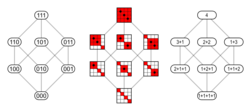Inspired by Thaddeus
 A composition of an integer is a way of representing a positive integer as a sum of other positive integers, where the order of the terms matter. For example, 3 can be composed in the following 4 ways:
A composition of an integer is a way of representing a positive integer as a sum of other positive integers, where the order of the terms matter. For example, 3 can be composed in the following 4 ways:
3 = 1 + 2 = 2 + 1 = 1 + 1 + 1 .
The product reduction of a representation, refers to multiplying each of these terms together. For example, we would obtain the values of 3 , 2 , 2 , 1 respectively. Out of these 4 products, 2 of them are odd and 2 of them are even.
How many odd product reductions of the composition of 10 are there?
This section requires Javascript.
You are seeing this because something didn't load right. We suggest you, (a) try
refreshing the page, (b) enabling javascript if it is disabled on your browser and,
finally, (c)
loading the
non-javascript version of this page
. We're sorry about the hassle.
2 solutions
@Chung Kevin This is a test
Let P ( n ) be odd product reductions of composition of n. Depending on the first number inserted P ( n ) can be written as,
P ( 2 k ) = ∑ i = 1 k P ( 2 i − 1 ) ,
P ( 2 k + 1 ) = 1 + ∑ i = 1 k P ( 2 i ) .
P ( 2 k + 1 ) = P ( 2 k ) + P ( 2 k − 1 ) (As, P ( 2 k − 1 ) = 1 + ∑ i = 1 k − 1 P ( i ) ),
P ( 2 k ) = P ( 2 k − 1 ) + P ( 2 k − 2 ) (As, P ( 2 k − 2 ) = ∑ i = 1 k − 1 P ( i ) ).
Hence, P ( n ) = P ( n − 1 ) + P ( n − 2 ) , with P ( 1 ) = 1 , P ( 2 ) = 1 .
Hence, P ( n ) = F n , for n > 0 ( F n is n t h fibonacci number. )
Let's take the Generating Functions approach.
Since we only want to use odd numbers in the composition, we should look at
f ( x ) = x + x 3 + x 5 + … = 1 − x 2 x
Since we can use an arbitrary number of partitions, we should look at
g ( x ) = f ( x ) + f ( x ) 2 + … = 1 − f ( x ) f ( x )
This is equal to g ( x ) = 1 − x − x 2 x . We recognize this as the generating functions for the Fibonacci numbers, hence the coefficient of x 1 0 in g ( x ) is F 1 0 = 5 5 .
Now that you know it's a pattern of Fibonacci numbers, can you prove it in another way?